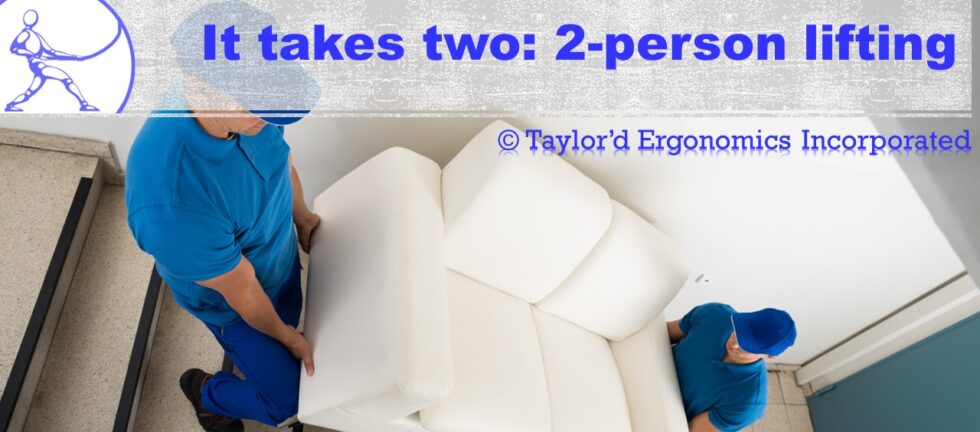We have all learned that, when something is too heavy to lift, we should get help. Ergonomists will usually remind you that help can be human or mechanical – a lifting device is often the best solution for moving something that is too heavy for one person. But in those situations where a lifting device is not available, here are tips for two-person lifting.
Effective communication is key
Lifting in sync is critical, and therefore communication with your lifting partner, before and while completing the task, is a key skill. If one person lifts or lowers before the other, both partners suffer an unexpected load, and this puts them at a higher risk of injury. Every successful lifting team has its own language. Decide, in advance, whether you will “lift on 3”(1-2-lift) or “lift after 3” (1-2-3-lift). Let either partner signal when to slow or speed the pace or take a break. Lifting partners build a relationship over time, and as Henry Winkler said, “Assumptions are the termites of relationships.”
Plan your route
Plan a walking path in advance. Remove or avoid obstacles and remember that one of you will be walking backwards, so make the route as easy as possible. Steps are difficult to negotiate as a one-person carry, but much more treacherous as a two-person task. Decide in advance who will lead and who will follow.
Get a grip
Before you lift a finger, plan how you will grip the object – we’ve all dropped a load or called a break halfway up the stairs because our hands were failing. Grip strength is often limiting while carrying large, awkward loads. Look for a way to grip the object with the hand wrapped fully around something like a handle, while standing as upright as possible. Wear gloves to distribute pressure on the fingers.
Orient the load
The object that you are carrying may need to be re-oriented during transit, for example to fit through a door, or to slide into an opening. Plan that in advance, or set the load down and figure it out, rather than struggling when your arms and back are tired.
Pick your partner
If you have a choice, choose a partner who is the same height as you, to split the load more equally. The shorter person in a two-person lift gets more than half the load.
Consider lifting straps
Lifting straps are another tool to explore for heavy two-person lifts. Experienced movers use straps as if they were an extension of their arms – it is magical to watch. Straps can be used for heavy items such as couches or appliances. They eliminate the need to grip, since the strap wraps around the arms or harnessed to the body, and this frees up your hands to stabilize the load. Straps extend the arms’ reach, so the body lifts in a more upright position. And since the weight hangs from the body or arms rather than the hands (closer to the spine), the load on the back is reduced. Lifting straps require practice, but they can be highly effective.
Is a 2-person lift really the most efficient solution?
If budget is the barrier to a lifting device for a heavy load, and you have settled on advising the worker to “get help,” be sure to consider the real cost of that decision. Getting a second worker is not always fast or efficient. A two-person lift can interrupt another person’s process, and, may even require two people on a job that one person could do if the proper equipment were available. The most efficient solution may be a mechanical device such as a hoist or stair-climbing cart, or a lift table and powered conveyors. Perhaps the load can be separated and moved in smaller parts.
Executed correctly, a two-person lift can reduce the risk of a worker’s injury, but effective communication is key. (Don’t be like Ross, in the TV show Friends, shouting “PIVOT!”)
Looking for safety talk content for two-person lifting? Ask Carrie about our microlearning, coming soon.
Reference: “The One With The Cop”, Friends, written by Gigi McCreery, Perry Rein and Alicia Sky Varinaitis, season 5, episode 16, aired on February 25, 1999.


